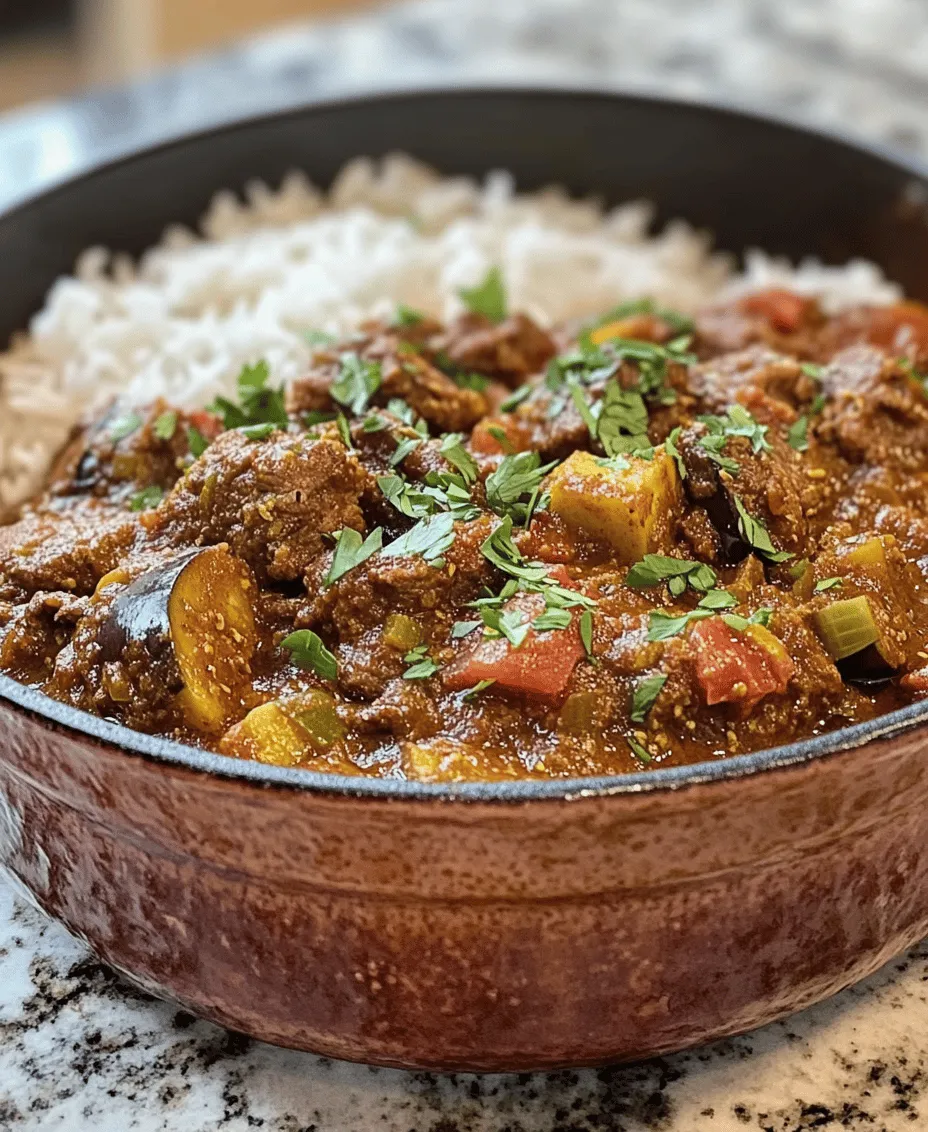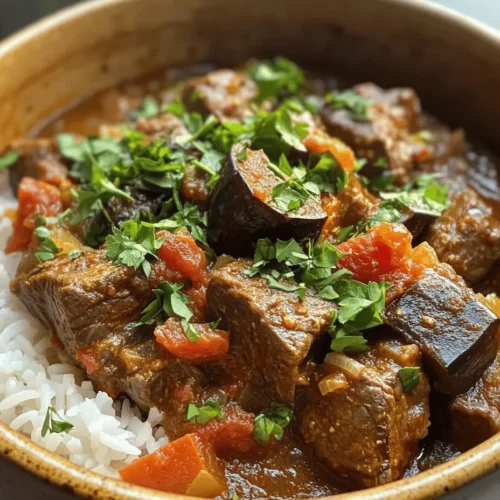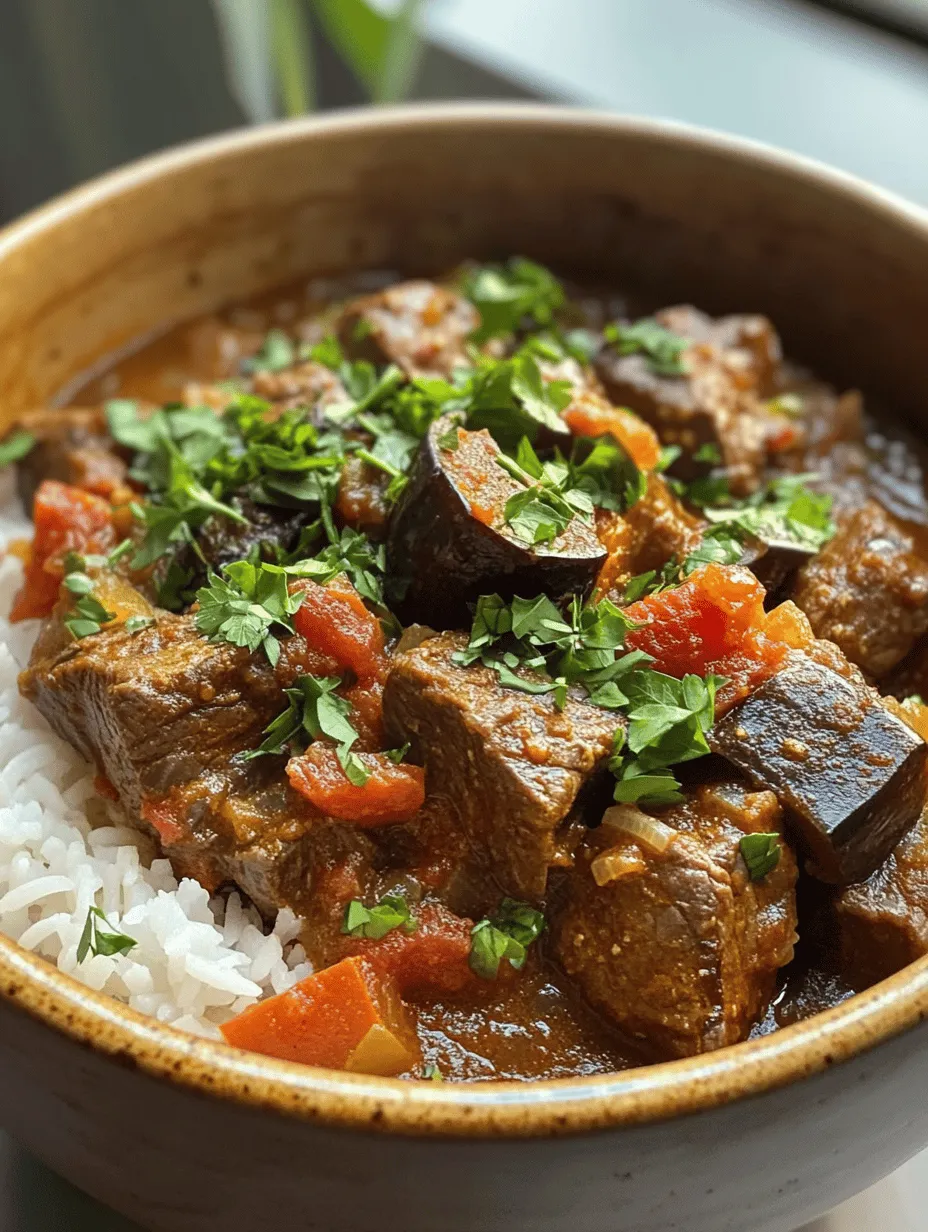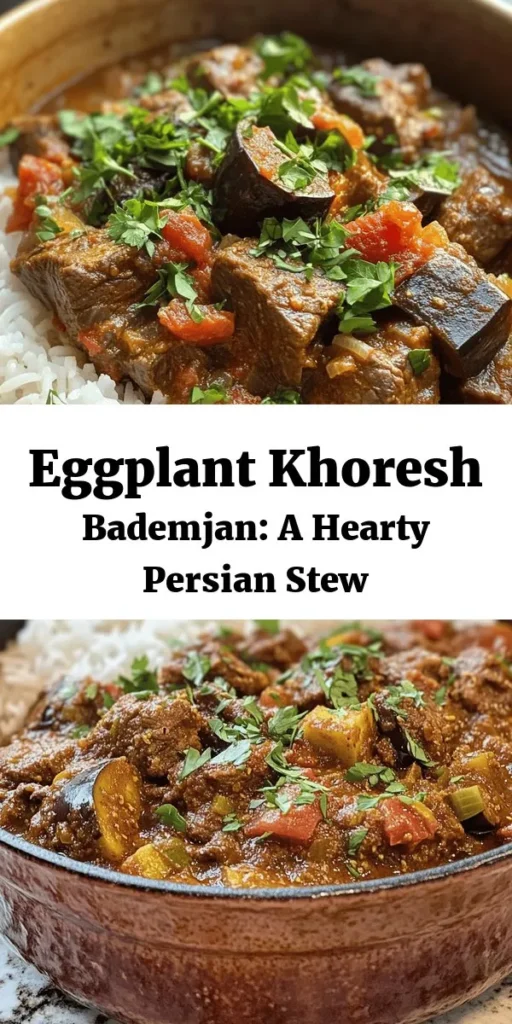Introduction
Khoresh Bademjan is more than just a dish; it is a culinary experience steeped in history and tradition, emblematic of Persian cuisine. This beloved Persian stew, characterized by its rich flavors and unique combination of eggplant and meat, has become a staple in households across Iran and beyond. As a dish that marries the earthiness of eggplants with tender, savory meat and fragrant spices, Khoresh Bademjan encapsulates the heart of Persian cooking, making it a favorite for both family gatherings and festive occasions.
What sets Khoresh Bademjan apart is not just its flavor profile but also its versatility. While the traditional recipe usually features lamb or beef, it can easily be adapted to suit vegetarian diets, often incorporating hearty chickpeas to maintain a satisfying texture. This adaptability not only caters to a wide range of dietary preferences but also showcases the dish’s cultural significance in bringing people together around the dinner table.
Despite its reputation for being a comforting meal, Khoresh Bademjan is deceptively simple to prepare. With a few essential ingredients and a step-by-step approach, anyone can create a pot of this delicious stew that is sure to impress family and friends. The satisfaction derived from preparing and sharing Khoresh Bademjan is unparalleled, making it a cherished recipe passed down through generations.
Understanding Khoresh Bademjan
The origins of Khoresh Bademjan can be traced back to the rich tapestry of Persian cuisine, which has evolved over centuries. The dish itself is thought to have roots in the diverse agricultural bounty of Iran, where eggplants are a staple ingredient. In Persian cooking, eggplants are revered not only for their unique flavor but also for their ability to absorb spices and enrich the overall taste of a dish. This makes them a perfect vehicle for the vibrant flavors found in Khoresh Bademjan.
Traditional cooking methods play a significant role in the preparation of this stew. The process involves slowly simmering, allowing the ingredients to meld harmoniously, resulting in a complex flavor profile that is both comforting and inviting. The use of spices such as turmeric and cumin is vital in enhancing the dish’s flavor, with each spice contributing its distinct character and warmth. Turmeric, known for its anti-inflammatory properties, adds a beautiful golden hue and earthy taste, while cumin infuses a nutty aroma that complements the eggplant and meat beautifully.
The Ingredients Breakdown
Essential Ingredients
– Eggplants: The star of Khoresh Bademjan is undoubtedly the eggplant. Its creamy texture and ability to absorb flavors make it an essential component of the stew. However, to ensure the eggplants do not impart bitterness to the dish, it is crucial to salt them before cooking. This process draws out excess moisture and helps eliminate any bitterness, resulting in a more balanced flavor.
– Meat Choices: Traditionally, Khoresh Bademjan is made with either lamb or beef, both of which bring a rich depth of flavor to the stew. When selecting meat, it is advisable to choose high-quality cuts that are well-marbled, as the fat content enhances tenderness and taste during the slow cooking process. For those opting for a vegetarian alternative, chickpeas serve as an excellent substitute, providing protein and texture without compromising the dish’s heartiness.
– Aromatics: Onions and garlic are the backbone of flavor in Khoresh Bademjan. Onions provide sweetness and depth, while garlic adds a fragrant note that elevates the dish. Sautéing these aromatics until they are golden and fragrant is essential, as this forms the flavor base upon which the rest of the ingredients build.
– Tomatoes: Fresh or canned tomatoes are another key component, contributing acidity and richness to the stew. The tomatoes not only enhance the overall flavor but also lend a beautiful color to the dish, making it visually appealing.
Spices and Seasonings
– Turmeric: Often referred to as the golden spice, turmeric is not just a vibrant addition to Khoresh Bademjan but also offers numerous health benefits. Its earthy flavor complements the other ingredients, while its anti-inflammatory properties make it a nutritious choice.
– Cumin and Cinnamon: Cumin brings a warm, nutty flavor that deepens the overall taste of the stew, while a hint of cinnamon introduces an unexpected warmth and sweetness. Together, these spices create a harmonious balance that epitomizes the essence of Persian cooking.
– Fresh Herbs: Finally, fresh herbs such as parsley, cilantro, or mint are often used as garnishes, adding an aromatic freshness and a burst of color that enhances both the flavor and presentation of the dish.
Broth and Acidity
– Broth Options: When it comes to the broth, one can choose between beef or vegetable broth. The choice significantly impacts the flavor profile, with beef broth imparting a richer taste that pairs beautifully with the meat, while vegetable broth offers a lighter alternative that allows the flavors of the eggplant and spices to shine.
– Citrus Element: A crucial component of Khoresh Bademjan is the addition of a citrus element, typically Persian lime juice or lemon. This acidity helps to balance the richness of the stew, cutting through the fat and elevating the overall flavor experience.
Step-by-Step Cooking Instructions
Preparing the Eggplants
To begin creating Khoresh Bademjan, the first step is to prepare the eggplants. This preparation is essential for achieving the best flavor and texture. Start by slicing the eggplants into thick rounds or half-moons, depending on your preference. Next, generously sprinkle salt over the cut surfaces and allow them to sit for about 30 minutes. This process draws out excess moisture and bitterness, ensuring that the eggplants remain tender and flavorful once cooked.
After the eggplants have rested, rinse them thoroughly under cold water to remove the salt and any released bitterness. Pat them dry with paper towels to remove excess moisture. This step is crucial, as it prevents the eggplants from becoming soggy during frying.
Frying Techniques
Once the eggplants are prepared, the next step is frying them. Heat a generous amount of oil in a large skillet or frying pan over medium heat. The oil should be hot enough to create a sizzle when the eggplants are added. Fry the eggplant slices in batches, ensuring not to overcrowd the pan. This allows for even cooking and browning, which enhances the flavor.
Cook the eggplants until they are golden brown on both sides and tender, usually about 3-4 minutes per side. Remove the fried eggplants from the pan and place them on paper towels to drain excess oil. This step is important for achieving the perfect texture, as it prevents the eggplants from becoming greasy.
Once the eggplants are fried and drained, set them aside while you prepare the rest of the stew. The frying process not only adds flavor but also helps to maintain the eggplant’s structure during the long simmering process ahead.
Now that the eggplants are prepared, the next steps will involve building the flavor base of Khoresh Bademjan with aromatics, browning the meat, and combining all the ingredients to create a rich, satisfying stew. Stay tuned for the continuation of this delicious recipe, where we’ll delve deeper into the cooking process and discover how to bring this traditional Persian delight to life in your kitchen.

The Art of Crafting Khoresh Bademjan Delight
Frying the Eggplants
To achieve the perfect Khoresh Bademjan, the first step involves frying the eggplants until they reach a delectable golden-brown color and a satisfying texture. Start by slicing the eggplants into thick rounds or long strips, depending on your preference. Once cut, sprinkle them generously with salt and let them sit for about 30 minutes. This process helps draw out excess moisture and bitterness, making for a more flavorful dish.
After the resting period, rinse the eggplants under cold water and pat them dry with paper towels. Use a large skillet or frying pan over medium-high heat, and add a generous amount of vegetable oil. The oil should be hot but not smoking—test it by placing a small piece of eggplant in the oil; if it sizzles, you’re good to go. Carefully place the eggplant slices in the skillet in a single layer, avoiding overcrowding, which can lead to steaming instead of frying.
Fry the eggplants for about 3-4 minutes on each side, or until they develop a rich golden-brown color. The goal is to achieve a crispy exterior while keeping the inside soft and creamy. Use a slotted spoon to remove the eggplants from the oil and place them on a paper towel-lined plate to absorb any excess oil. This frying process not only enhances the flavor but also adds a delightful texture to the stew.
Sautéing the Aromatics
Now that your eggplants are perfectly fried, it’s time to sauté the aromatics. In the same skillet where you fried the eggplants (draining excess oil if necessary), add a tablespoon of fresh oil over medium heat. Introduce finely chopped onions and sauté them until they become translucent, which should take about 5-7 minutes. The key here is low and slow—too high a heat can burn the onions, leading to a bitter flavor.
Next, add minced garlic and stir for an additional minute, just until fragrant. This step is crucial; developing the flavor of the onions and garlic will form the aromatic backbone of your Khoresh Bademjan. If you wish to add spices like turmeric or cumin at this stage, do so sparingly as they can burn quickly. The goal is to create a fragrant base that will enhance the overall depth of your stew.
Cooking the Meat
Once your aromatics are beautifully sautéed, it’s time to introduce the meat. Choose between lamb or beef, cutting it into bite-sized pieces. Increase the heat to medium-high to brown the meat. Adding it to the pan in a single layer allows for proper browning, which is essential for flavor. Cook the meat for about 6-8 minutes, stirring occasionally until all sides are nicely browned.
Browning the meat not only locks in moisture but also adds a rich, savory depth to the stew. The fond—those flavorful brown bits stuck to the bottom of the pan—will be deglazed in the next steps, further enhancing your dish. Once the meat is browned, season it with salt and pepper to taste.
Building the Stew
Now that the base for your Khoresh Bademjan is set, it’s time to build the stew itself. Add chopped tomatoes (fresh or canned) to the pot, along with tomato paste if you desire a richer tomato flavor. This combination will provide acidity and sweetness to counterbalance the savory elements. Pour in enough broth or water to cover the meat, typically about 2-3 cups, and bring it to a gentle boil.
Once boiling, reduce the heat to low, cover the pot, and let it simmer. This simmering phase is vital; it allows the flavors to meld beautifully over time. Aim for at least 45 minutes to an hour, stirring occasionally to prevent sticking. The longer you let it simmer, the more complex and deeply flavored your Khoresh Bademjan will become.
Incorporating the Eggplants
After the meat has tenderized and the flavors have developed, it’s time to incorporate the fried eggplants. Gently fold them into the simmering stew, taking care not to break them apart. This step is important, as the eggplants will absorb the rich flavors of the stew while still maintaining their shape and texture.
Allow the stew to simmer for an additional 20-30 minutes, uncovered. This will help the eggplants soften further while retaining their integrity. At this point, you can adjust the seasoning, adding more salt or pepper if necessary. If you prefer a thicker stew, let it simmer uncovered to reduce the liquid further.
Final Cooking Phase
As the final cooking phase comes to an end, you’ll want to give your Khoresh Bademjan a last tasting check. The flavors should be well-balanced, aromatic, and inviting. If you like a touch of sweetness, consider adding a small amount of sugar or a splash of lemon juice to brighten the flavors.
Once satisfied, remove the pot from the heat and let it sit for about 10 minutes before serving. This resting period allows the flavors to settle and intensify, resulting in a more harmonious dish.
Serving Suggestions
Traditional Accompaniments
Khoresh Bademjan is traditionally served over fluffy basmati rice, which complements the stew’s rich flavors and provides a lovely textural contrast. The rice soaks up the stew’s juices, making each bite a delightful experience. Alternatively, warm flatbread such as lavash or pita can be served alongside to scoop up the stew.
For an authentic touch, you can also prepare a side of saffron-infused rice. This adds a beautiful color and fragrance, elevating the dish’s presentation. The aromatic steam from the basmati rice combined with the rich khoresh creates a feast for the senses.
Presentation Tips
To enhance the visual appeal of your Khoresh Bademjan, consider garnishing it with fresh herbs like chopped parsley or cilantro. A few strands of saffron sprinkled on top not only adds a touch of luxury but also an earthy flavor that complements the dish beautifully. Serve in a large, shallow bowl to showcase the vibrant colors of the stew, and don’t forget to include a side of lemon wedges for those who enjoy a bit of acidity to balance the richness.
The Health Benefits of Khoresh Bademjan
Khoresh Bademjan is not only a comforting and delicious meal but also packed with nutritious ingredients. Eggplants are a star in this dish, known for their high fiber content and antioxidant properties. They are low in calories and contribute to heart health, thanks to their potassium and vitamin K content.
The spices used, such as turmeric and cumin, offer anti-inflammatory benefits and can help boost metabolism. Additionally, vegetables like onions and tomatoes contain essential vitamins and minerals, making this stew a wholesome option for those looking to enjoy a hearty yet healthy meal.
Variations of Khoresh Bademjan
Khoresh Bademjan has several regional variations across Persian cuisine. In some regions, you may find the addition of split peas or lentils, which add another layer of texture and nutrition. Others may include dried fruits such as apricots or prunes for a touch of sweetness, transforming the dish into a delightful sweet-savory experience.
Alternative cooking methods, such as slow cooking or pressure cooking, can also adapt this recipe for convenience. A slow cooker allows the flavors to develop over an extended period, while a pressure cooker significantly reduces cooking time without sacrificing taste. Whichever method you choose, the essence of Khoresh Bademjan remains a cherished staple in Persian households.
Conclusion
Preparing Khoresh Bademjan Delight is both a culinary adventure and a means of connecting with Persian culture. The process of frying, sautéing, and simmering transforms simple ingredients into a complex and flavorful stew that brings warmth and comfort to the table. Its significance in Persian cuisine lies not only in its rich taste but also in its ability to bring family and friends together.
As you explore this recipe, you’re not just cooking a meal; you’re immersing yourself in a tradition that celebrates flavors and togetherness. We encourage you to try Khoresh Bademjan and discover the joy of this delightful dish. Whether you are sharing it with loved ones or savoring it alone, Khoresh Bademjan offers an invitation to experience a piece of Persian heritage, one delicious bite at a time.



